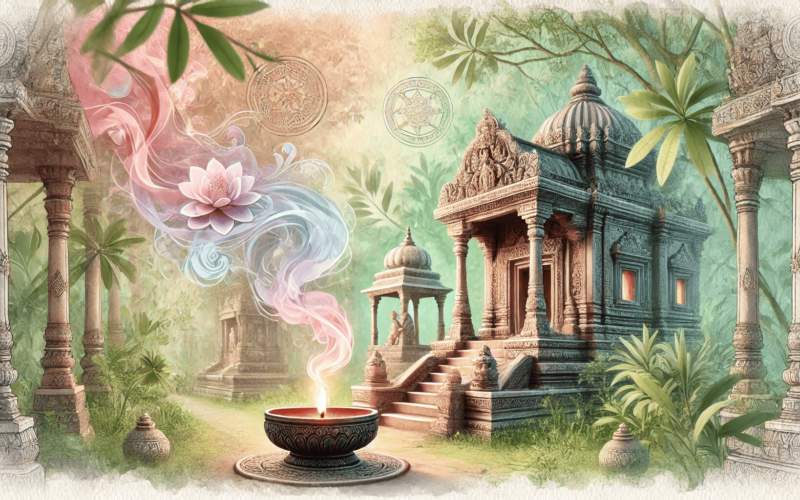Sometimes, in order to preserve the memory of lost cultural heritage objects, it is necessary to use unusual and unexpected methods. One of these methods is perfume, which is able to recreate the smells that have disappeared from our lives. The memory of traditions and crafts that were lost can be revived with the help of aromas that have become an integral part of the history of civilization. Fragrance is the key that can take us back to long-forgotten eras and give us a sense of how our ancestors lived.
Many ancient civilizations, such as Egypt or Greece, attached special importance to scents in their daily lives. Scents were used not only in religious rituals, but also to create cosmetics, medicines, and even as a symbol of well-being. The history of perfumery goes back to ancient times, and each culture created its own unique compositions that reflect its identity. However, over time, many of these scents were lost, and it was not an easy task to recreate them. Modern technologies, such as radio-controlled models for aerial photography, open up new horizons for studying history and help to create more accurate representations of the past.
The task of restoring lost aromas requires the use of the latest technologies and knowledge in the field of perfumery. Modern perfumers, combining various ingredients, can create compositions that will smell like the very aromas that were once present in the life of our ancestors. This opens up new horizons for the study of historical heritage and helps to recreate forgotten moments of the past. Perhaps it is thanks to perfumery that it will be possible to restore not only the aromas, but also the atmosphere of entire epochs.
Recreating ancient scents and traditions
One of the most striking examples of the use of perfumes to restore cultural heritage is the project to recreate the aromas of ancient Egypt. Research shows that the Egyptians used unique blends of oils and aromatics to create perfumes and as air fresheners. However, over time, the recipes of these scents were lost, and now scientists and perfumers are engaged in restoring the lost formulas. Using ancient texts and remnants of aromatic resins, perfumers try to recreate scents that could transport us to a world where such scents were part of everyday life.
Similarly, other fragrance-related trends can be restored. In India,for example, aromatic oils were used for meditation and rituals, creating an atmosphere for deep spiritual practices. Today, perfumers use their knowledge of the composition of these oils to create scents that will help restore the atmosphere of those ancient rituals to our world. Scents become a kind of bridge between modernity and the cultural traditions that we need to preserve.
Fragrance recovery technologies make it possible not only to restore forgotten smells, but also to create new ones that can become symbols of modern cultures. Some countries have already started using perfume compositions as a means to preserve cultural monuments. For example, scents associated with certain historical sites can become part of cultural tourism, allowing tourists to feel the atmosphere of antiquity and recreate the feelings of that time.
Aromas and their connection to extinct cultures
Perfumery not only helps to recreate images of bygone times, but also reveals the deep connection between scents and cultural identities. Each society used unique scents to express its traditions, beliefs, and lifestyle. In Egypt, for example, aromatic oils were part of divine rituals, and in ancient Greece, scents were often used in philosophical teachings. Each smell was not just a memory, but also an important element in preserving cultural identity.
Today, perfumers, exploring ancient recipes and using modern technologies, are trying to restore the aromas of vanished cultures. This is a difficult task, because many components that were used thousands of years ago are now impossible to find. Some substances, such as rare resins or oils, have been lost due to climate change or depletion of natural resources. However, thanks to archival sources and scientific research, it is possible to create odors close to those used in ancient times. An important aspect of such projects is the attention to historical details.
Several techniques can be used to restore the fragrance, including the following:
- Study of archaeological finds, such as fragments of vessels with the remains of aromatic oils.
- Working with ancient texts that describe the composition of aromatic mixtures.
- Modern synthesis methods that allow you to recreate rare substances mentioned in historical sources.
- Collaborate with historians and ethnographers to accurately reproduce not only the smell, but also the atmosphere associated with it.
Each of these techniques helps create scents that recreate entire epochs and give us a unique opportunity to experience them for ourselves.
Recreating the smells of vanished traditions
Perfumery has a unique ability to recreate not only the aromas, but also the atmosphere of long-gone times. When it comes to traditions that have gone into the past, scents become a link between generations. Many cultural practices, such as the rituals associated with perfumes, go into oblivion, but perfumery offers the opportunity to bring them back into our perception. With the help of aromas, we can not only remember, but also feel those customs that have become part of the historical memory of mankind.
Recreating the scents of vanished traditions requires special attention to detail, because many of these scents are unique and associated with certain rituals or time periods. Research and archaeological excavations provide scientists with valuable data on what substances were used at certain historical moments. Modern perfumers can combine these old ingredients with new ones to create authentic scents. Thus, the restored smells allow us not only to learn more about the culture, but also to recreate the emotional context of those events.
Perfumery is becoming an important tool for preserving cultural traditions, so that the disappeared smells can be re-experienced. This helps to restore not only the customs, but also the general atmosphere of those times, where smells played no less a role than visual or sound images. We are already starting to see the use of restored scents in museums and cultural events, which allows people to feel a living connection with history. Creating such scents is not just an art, but a real bridge between the past and the present, which gives us a unique sense of time.
The use of scents in cultural heritage
When we turn to the study of odors, it becomes clear how important they are for the preservation of cultural heritage. Odors can tell you much more about traditions and customs than historical documents or even works of art. Scents were once part of rituals, festivals, and social ceremonies, and they created a unique atmosphere for those who experienced them. Today, thanks to modern technologies, it is possible to restore and even relive many of these smells, which is an important step in preserving historical memory.
To recreate the smells of vanished traditions requires not only knowledge of chemistry and perfumery, but also respect for cultural contexts. Every fragrance created in ancient times carried an important meaning, whether it was a symbol of power, religious connection or belonging to a particular stratum of society. Based on this knowledge, modern perfumers can not only recreate the smells, but also accurately convey their role in the life of those times. By recreating the smells, we can feel the atmosphere of the lives of those who lived before us, and better understand their values and beliefs.
It is in perfumery that an amazing combination of science and art is revealed, which opens up a new perspective on our heritage. Creating scents from the past helps to restore images of vanished cultures more fully and finds its application in a wide variety of areas, from museum exhibitions to cultural tours. This practice contributes not only to the preservation of historical memory, but also to the development of cultural identity in the modern world. Perfumery thus becomes not just an industry, but an important link in the chain of preserving our common cultural heritage.
Questions and answers
Perfumery allows you to recreate scents that were an important part of cultural and religious practices. Modern perfumers use historical data and archaeological research to create scents that help bring back the vanished traditions and atmosphere of past eras.
To restore the odors of ancient civilizations, methods such as the study of archaeological finds, the study of ancient texts and the synthesis of rare aromatic substances are used. These technologies allow you to recreate flavors that are close to those used in the past.
Scents are becoming an important tool in preserving cultural identity. They help you not only learn about traditions, but also experience the atmosphere of past eras, creating an emotional connection with history and culture.

